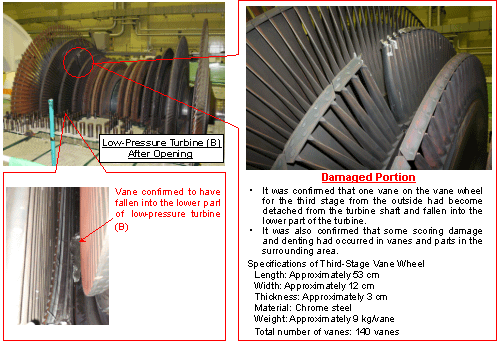Only the most hard boiled egg heads took much notice when on June 15 the Hamaoka-5 reactor (ABWR 1380 MW) shut down automatically due to "excessive turbine vibration", so it was quite a shock when Chubu Electric Power Company announced the reason for this excessive vibration. A vane on one of the wheels of low-pressure turbine B had broken completely off the turbine shaft and fallen into the lower part of the turbine (see diagram). Of course, when a turbine is rotating at 1,800 revolutions per minute, a broken vane does not simply fall, it flies. Not surprisingly, therefore, Chubu Electric found that "there was some scoring damage and denting on other vanes and parts in the surrounding area."
Fractures or cracking were found in connectors (forks) at the roots of the vanes in all three of the turbines. Cracking was also found in some of the vane connectors on the shaft. As at July 11th, besides the vane that flew, fractures or cracks had been discovered in 247 vanes (of 279) in low-pressure turbine B. Fractures or cracks had also been found in 185 (of 280) and 230 (of 280) vanes in low-pressure turbines A and C respectively.
Hamaoka-5 is the third last reactor to come on line in Japan. It commenced operations on 18 January 2005. It is one of four advanced boiling water reactors (ABWR) in Japan. The turbine was made by Hitachi and is the same design as Hokuriku Electric Power Company's Shika-2 (ABWR 1358 MW) reactor, which commenced operations on 15 March 2006. The Nuclear Industrial and Safety Agency ordered Hokuriku Electric to shut down Shika-2 for inspection and some cracks have already been found. (As reported in NIT 112, Shika-2 should by rights have been closed down after a March 24th verdict of the Kanazawa District Court, which concluded that it was unsafe to operate in the event of an earthquake.)
Hitachi has admitted that it believes the cracked and broken vanes are the result of a design problem and that it will probably take some time to resolve the problem. This is good news for earthquake safety, since it means two particularly unsafe reactors could be down for quite a long time. However, it is bad news for Japan's nuclear manufacturers. They are very proud of their ability to build ABWRs and are eager to market this type of reactor world-wide. As reported in NIT 101, Toshiba and Hitachi exported ABWR reactor pressure vessels for Taiwan's No. 4 Nuclear Power Plant. Also, Hitachi is lining up to sell ABWRs to a US utility (see News Watch).
The problems with Hitachi's ABWR turbine vanes will not help its reputation as a reliable nuclear power plant maker. Indeed, the day may come when it will say, "Because of those vanes our export efforts were in vain."
Philip White (NIT Editor)
 |
|
Diagram and accompanying explanation by Chubu Electric
|
Return to NIT 113 contents

